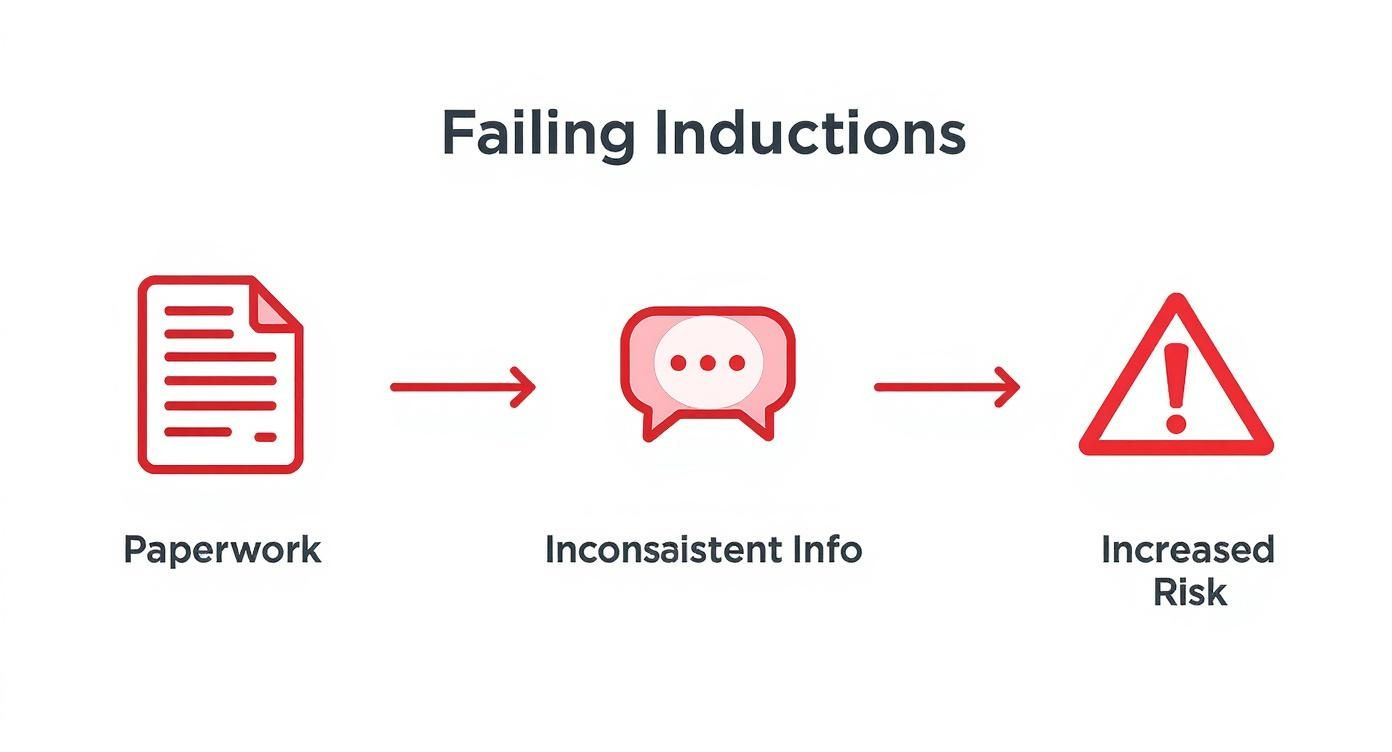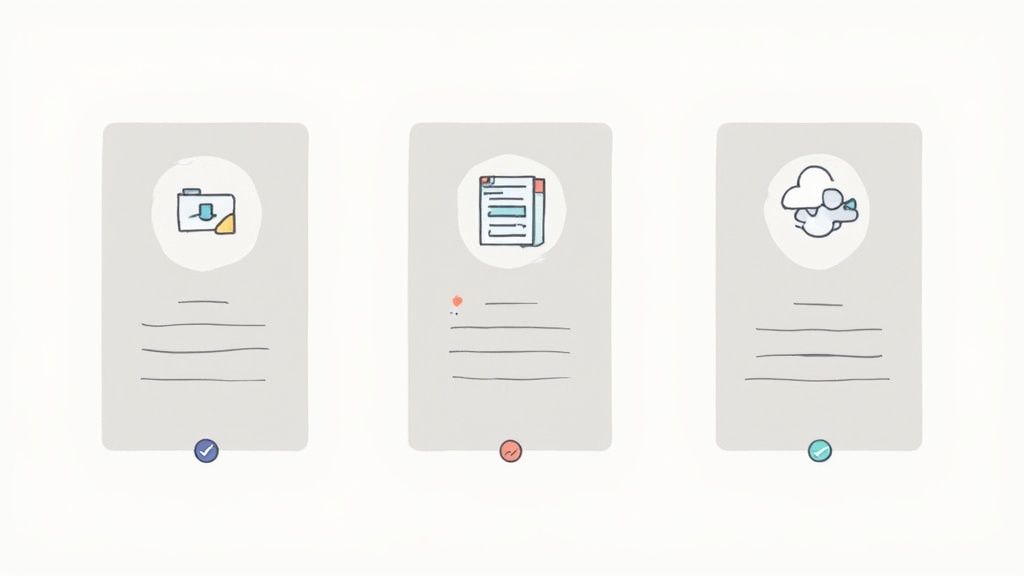A solid site induction template is more than just a checklist; it's your first line of defence against inconsistency. It makes sure every single person, from a new hire to a short-term contractor, gets the same critical safety information before they step onto your worksite. It's about swapping out verbal briefings and messy paper forms for a clear, repeatable, and trackable process.
The Real Costs of a Bad Induction
If you're still juggling a stack of paper forms or just relying on a supervisor's memory to run site inductions, you’re exposing your project to risks and costs you can’t afford. An inconsistent induction isn't just a minor admin headache. It's a direct threat to your project's timeline and, more importantly, your workers' safety.
The old way of doing things doesn't work. It’s unreliable, impossible to track properly, and often leaves dangerous gaps in people's knowledge.
When one contractor is told to use a specific access point and another is told something completely different on the same day, you’ve got a problem. This isn't a rare scenario; it happens all the time on sites that depend on word-of-mouth briefings. The result is confusion, delays, and people second-guessing the correct procedure when they should be focused on their work.
Wasted Hours and Hidden Risks
A disorganised induction process burns through more than just paper. Think of the supervisor's time, eaten up by explaining the same basic site rules over and over. Or the project delays that happen when a subcontractor shows up unprepared because their induction was rushed or incomplete. These "small" issues add up fast.
A major reason old-school inductions fail is that the content is just plain boring. For some practical pointers on fixing this, check out these tips for making effective training videos that actually hold people's attention.
The financial hit from poor onboarding is big. In Australian workplaces, a good induction can cut employee turnover by a huge 82% and improve new hire productivity by 70%. On the flip side, getting it wrong can cost a business around $18,000 for every single hire that doesn't stick.
The biggest danger of a bad induction is inconsistency. When every worker and contractor receives a slightly different version of the rules, you no longer have a single standard for site safety. You have dozens of conflicting ones.
The Problem of Incomplete Information
With a paper-based system, it's almost impossible to be certain that everyone has received and understood critical updates. Let’s say an exclusion zone on a busy construction site has to be moved. How do you guarantee every single person on site knows about it? A notice pinned to a board is easily missed.
This is exactly the problem a proper site induction template solves. It creates a single source of truth. You get a clear, documented record proving that every individual has been given the exact same essential information, from emergency muster points to site-specific hazards. This isn't just about ticking a box for compliance; it's about building a predictable and safe working environment from day one.
Assembling Your Core Induction Template
Right, let's get into building your site induction template. The goal here isn’t to create another generic document that gets skimmed and forgotten. We're aiming for a practical tool that gives every single person walking onto your site the exact information they need to work safely and efficiently.
Think of it as the operating manual for your specific site.
To get this right from the start, it helps to apply some solid knowledge management best practices. This just means structuring the information so it’s organised, dead simple to update, and actually useful to the people who need it.
When inductions are a mess of disorganised paperwork and verbal instructions, you get inconsistency. That inconsistency is what directly leads to increased risk on site.

As you can see, the problem often starts with outdated methods, sparking a chain reaction that can compromise safety before a worker even picks up a tool.
So, where do we start? Let's break down the essential sections that every robust induction template needs.
We've put together a simple table outlining the non-negotiables for any site induction template. Think of this as your checklist to make sure you're covering all the critical bases for both compliance and genuine on-the-ground clarity.
Essential Sections for Your Site Induction Template
| Section | What to Include (Examples) | Why It Matters |
|---|---|---|
| Key Site Information & Contacts | Full site address, map of access points, key contacts (Site Manager, First Aid Officer), site operating hours. | This is the "who, what, where." It grounds everyone and tells them exactly who to call for help, no guesswork involved. |
| Site-Specific Hazards & Controls | "Uncovered reo bars in foundation works" (Control: Must be capped). "Automated machinery paths" (Control: Stay in walkways). | Every site is unique. Generic warnings don't work. This section links real hazards to specific, actionable controls. |
| Emergency Procedures | Map of exits/muster points, alarm sounds, step-by-step actions for fire/medical events, emergency numbers. | In a crisis, confusion is dangerous. This section provides clear, immediate instructions to keep people safe. |
| Site Rules & Policies | PPE requirements, vehicle speed limits, smoking/phone policies, clear steps for reporting hazards and incidents. | This sets the baseline expectations for how to act on site. It's about creating a predictable and safe work environment. |
By building your template around these core pillars, you ensure that everyone, from a new subcontractor to a seasoned employee, gets the same consistent and vital information.
Key Site Information and Contacts
First things first, people need to know the basics. This section grounds them in the specifics of the workplace and points them to the right people for help.
Your template absolutely must state:
- The full site address and main access points. If your site is large or has multiple gates, a simple map or diagram is a game-changer.
- Key personnel and their contact details. We’re talking the Site Manager, First Aid Officers, and the Health and Safety Representative. Make it obvious who to call for what.
- Site operating hours. Be clear about standard work times, breaks, and any rules around after-hours work.
Site-Specific Hazards and Controls
Every site has its own personality and its own risks. A fabrication workshop is a world away from a multi-storey construction project, and your induction must reflect that reality.
Don’t just write down "slips and trips." Get specific. For a building site, you might list "Uncovered reo bars in foundation works" and state the control is "All exposed rebar must be capped immediately." In a factory, a hazard could be "Automated machinery movement paths," with the control being "Pedestrians must remain within marked walkways at all times."
If you're looking for more guidance to make sure you've covered all your bases, a comprehensive WHS induction checklist is an invaluable resource.
Emergency Procedures
When an alarm goes off, there’s no time for confusion. This part of your template is all about removing the guesswork by giving clear, direct instructions for when things go wrong.
Be sure to include these critical details:
- A map showing all emergency exits, assembly points (muster points), and where to find fire extinguishers and first aid kits.
- The specific sounds of different alarms (e.g., is that the evacuation alarm or a first aid alert?).
- Step-by-step instructions for what to do in case of a fire, medical emergency, or chemical spill.
- Emergency contact numbers that are visible and easy to find.
The goal is to provide information that is immediately useful. A worker should be able to glance at their induction summary and know exactly where to go and what to do in an emergency, without needing to ask.
Site Rules and Policies
Finally, you need to outline the non-negotiables for your workplace. This section is where you set clear expectations for everyone who steps foot on your site, from your own team to subcontractors and visitors.
Cover the essentials like Personal Protective Equipment (PPE) requirements, speed limits for vehicles, and policies on smoking or mobile phone use in work areas. It's also crucial to include procedures for incident and hazard reporting, explaining exactly who to notify and how. By being direct and specific, you create a solid foundation for a well-managed and safe site.
Meeting Your Legal and Compliance Duties
Let's be clear: a solid site induction isn't just a nice-to-have, it's a legal requirement. Here in Australia, the WHS Act is explicit: you have a primary duty of care to provide specific safety information to every single person before they set foot on your site to work. This process is your proof that you’ve done your bit.
Trying to get around this isn't an option. Site-specific inductions are mandated by law, and the focus is especially sharp in high-risk sectors like construction. There's a grim reason for that. Construction, along with agriculture and transport, consistently ranks among the top industries for workplace fatalities. A proper induction has to cover the unique hazards, control measures, and emergency procedures for that specific location.
A critical part of this legal duty is keeping good records. It’s not enough to just run an induction; you have to be able to prove who was inducted, when it happened, and what information they actually received. This is where a proper site induction template becomes your best friend, creating an automatic, time-stamped trail that protects your business.
From a Scrappy Form to Solid Proof
Let's play out a scenario. A subcontractor has a minor incident with a piece of machinery and claims they were never shown the specific lockout-tagout procedure for that equipment.
If your induction was a quick verbal rundown and a signature on a smudged, generic form, you’re in a tough spot. You have no real way to prove what was covered, leaving you wide open to disputes and potential regulator action. Your records are weak, and so is your defence.
Now, let's rewind. Imagine the same incident, but this time you're using a digital site induction system. You can instantly pull up a record showing the exact date and time the subcontractor completed their online induction. Better yet, you can show they passed a short quiz specifically confirming they understood the lockout-tagout module.
The argument is over before it even begins. Your clear, documented process proves you met your obligations.
Your induction records are your first line of defence. In any dispute, a detailed, time-stamped digital record is infinitely more credible than a simple signature on a piece of paper. The aim is to leave absolutely no room for doubt.
Tying It All Together
Your legal duties don't exist in a vacuum; they tie directly into your entire risk management process. The information you build into your induction template should be a direct reflection of your site's risk assessments.
Identifying hazards is half the battle, but communicating them effectively through your induction is what makes the difference. A well-structured WHS risk assessment template will help you pinpoint exactly what needs to be in that induction.
This alignment ensures your induction isn't just a tick-box exercise. It becomes a practical, living extension of your safety management system, directly addressing the real-world risks your people will face every day. It turns compliance paperwork into a genuinely useful tool that keeps your site safe and running smoothly.
Choosing a Practical Format for Your Template
A well-structured site induction template is only as good as the system you use to manage it. Let’s be honest, if it’s a pain for people to use, it won’t be effective. The format you choose dictates how easy it is to update, track completions, and present information clearly. Picking the right system from the start saves a lot of headaches later.

Many businesses start with what feels easiest: a fillable PDF or a shared spreadsheet. I’ve seen it countless times. While these are low-cost, they create big problems down the line.
How do you track who has completed the induction in real-time? What happens when a site hazard changes and you need to update the document for everyone instantly?
These manual methods quickly become clunky and hard to manage, especially with multiple contractors or sites. They offer zero version control, making it nearly impossible to prove that a specific worker saw the most current safety information. This is a huge risk, and it’s why so many companies are moving towards better systems.
Comparing Your Options
Online site induction programs are now a major trend across Australian workplaces, and for good reason. They are efficient, save costs, and standardise essential information across different sites. According to inductforwork.com.au, this digital approach makes sure training is delivered consistently, which is crucial for compliance. You can learn more about the rise of online inductions on their website.
To help you decide what’s right for you, let’s take a practical look at the pros and cons of the most common formats out there.
Induction Template Format Comparison
Here's a breakdown to help you weigh up the different formats for managing your site inductions.
| Format | Pros | Cons | Best For |
|---|---|---|---|
| Fillable PDF / Word Doc | Cheap to create, familiar software. | Impossible to track completions automatically, difficult to update for everyone, no version control. | Very small teams on a single, static site with minimal changes. |
| Shared Spreadsheet | Can act as a basic completion register. | Prone to errors, messy to manage, not engaging for users, poor for media like videos. | Tracking a small number of contractors where detailed induction content isn't managed in the sheet. |
| Online Induction Software | Automated tracking and records, easy to update instantly, can include quizzes and videos, centralises all information. | Requires a subscription cost. | Businesses of any size needing reliable compliance records, multi-site operations, and an efficient process. |
As you can see, while paper-based methods might seem like the simple route, they often create more work and risk in the long run.
Making the Practical Choice
When selecting a format, the key questions are practical ones. How will you prove who completed the induction and when? How quickly can you roll out a critical update to every single person on every site?
Using dedicated software solves these issues by creating a single, reliable system. It automatically logs completions, timestamps everything, and makes sure that any updates are pushed out immediately. This creates a solid audit trail that protects your business when it matters most.
This level of organisation is exactly what a good safe operating procedures template does. It provides clear, repeatable instructions for specific tasks. Your induction format should offer the same reliability for your overall site safety information.
The best format is the one that makes your job easier, not harder. If you spend more time chasing signatures and updating spreadsheets than managing site safety, your system is broken.
Ultimately, the small upfront cost of a software solution often pays for itself by cutting down on admin time and reducing the risk of costly compliance gaps. It provides a professional, trackable, and always-current site induction template that works in the real world.
Adapting Your Template for Different Roles and Sites
Let’s be honest: a one-size-fits-all induction is a recipe for wasted time. A project manager doesn’t need a deep dive into operating a specific grinder, and a short-term visitor definitely doesn't need to sit through the entire project timeline. To be effective, your site induction template has to be flexible enough to deliver the right information to the right person.
It's all about relevance.

The best way I’ve found to do this is by taking a modular approach. You build a core foundation of must-know info that applies to everyone, then you layer on specific modules for different roles, risks, or work areas. This keeps the induction focused and makes sure people only get the information they genuinely need to stay safe.
Think of it like building with Lego. Everyone gets the same base plate, but you add different coloured bricks depending on what they're there to build.
Building the Core Foundation
The core of your induction template needs to cover the absolute non-negotiables. This is the information every single person must know, no matter what their job is. It's your universal baseline for site awareness, and it’s mandatory for all personnel.
This foundational module should be short, sharp, and include:
- General Site Access and Layout: Where to park, entry points, and the location of key amenities like toilets and lunchrooms.
- Key Personnel: Who the site manager and first aid officers are, and more importantly, how to get hold of them.
- Universal Emergency Procedures: What the alarms sound like, where the primary muster point is, and who to report an emergency to.
- Fundamental Site Rules: The absolute minimum PPE required just to walk around the site and general expectations for conduct.
This part should be quick and clear. It’s for everyone, from the CEO doing a walkthrough to a delivery driver dropping off a pallet. It just sets the scene before anyone gets into the details of their specific job.
Adding Role-Specific Modules
Once that core is locked in, you can create separate, targeted modules for different groups. A large construction project is the perfect place to see this in action. You'd never give the same induction to a crane operator, an electrician, and a visiting consultant. It just wouldn't make sense.
Here’s how you could break down these add-on modules:
- For High-Risk Work: An electrician’s module would need to cover specific lockout-tagout procedures, the permit-to-work system, and the location of isolated switchboards. A plasterer just doesn’t need to know this.
- For Machinery Operators: A crane operator needs modules on lift plans, exclusion zones, communication protocols with doggers, and the pre-start checks specific to the cranes you have on site.
- For Subcontractor Teams: A scaffolding team might get a module detailing specific anchor points, load limits for different areas, and the strict rules around modifying any part of the scaffold.
- For Visitors and Deliveries: Keep it super short. A quick module covering sign-in procedures, designated waiting areas, and who they must be escorted by is plenty. This avoids burying them in technical details they'll immediately forget.
A modular site induction template shows you respect people's time. By giving them only the safety information that directly impacts their work, you're showing you understand their role, and they're far more likely to actually pay attention.
When you structure your template this way, you create a system that's both comprehensive and efficient. Everyone gets the essential baseline info, plus the detailed instructions they need to do their job safely. This targeted approach is much more effective than forcing everyone through the same long, generic document.
Have Questions About Site Inductions? We’ve Got Answers.
Even with a rock-solid induction template, you're bound to run into questions. Here are a few of the most common ones we hear from managers on the ground, along with some straight-up, practical advice.
How Often Should a Site Induction Be Updated?
Think of your site induction as a living document, not a set-and-forget file. It has to be reviewed and updated anytime there’s a significant change on your worksite.
This could be the arrival of new machinery, a major shake-up to the site layout, or a change in your emergency procedures. As a bare minimum, you should be doing a full review of all your induction content at least once a year. It’s the only way to make sure everything is still accurate and lines up with current regulations.
What Is the Difference Between a General and a Site-Specific Induction?
It’s pretty simple. A general induction, like a construction White Card, covers the big-picture safety rules for an entire industry. It’s the foundational knowledge every worker needs to have about common hazards.
A site-specific induction gets right down to the details of one particular workplace. It’s where you cover the unique hazards, rules, and procedures that apply only to that specific location. You need both; one gives workers the general rules of the road, the other tells them precisely how to stay safe on your site, today.
A general induction teaches a worker the road code. A site-specific induction gives them the map for your job site, pointing out the local hazards, one-way streets, and emergency exits.
Can a Site Induction Be Done Entirely Online?
Absolutely. Running your site induction online before a worker even steps foot on-site is an incredibly efficient way to handle the essential rules, policies, and general hazard awareness. It saves a huge amount of time on their first day.
But the best approach is usually a hybrid one. Get them to complete the online module first, then follow it up with a quick, in-person check when they arrive. A supervisor can physically point out the muster points, show them the first aid kits, and answer any last-minute questions. That mix of digital efficiency and a real-world walkthrough is hard to beat.
How Do I Confirm Workers Understood the Induction?
A signature on a form just proves they can hold a pen, it doesn't prove they understood a thing. The most practical way to check for comprehension is to finish your induction with a short, simple quiz.
Five to ten straightforward, multiple-choice questions on the most critical safety points will do the trick. Focus on the must-knows, like what the emergency alarm sounds like or who they need to report an incident to. Requiring a 100% pass mark before granting site access is a clear, documented way to make sure the key messages have actually sunk in.
Managing safety documentation shouldn't be a constant headache. Safety Space replaces messy paperwork and confusing spreadsheets with a simple, all-in-one platform that makes compliance easy. Get a clear view of your entire H&S system and book your free demo.
Ready to Transform Your Safety Management?
Discover how Safety Space can help you build a safer, more compliant workplace with our comprehensive safety management platform.
Book a Free DemoRelated Topics
Safety Space Features
Explore all the AI-powered features that make Safety Space the complete workplace safety solution.
Articles & Resources
Explore our complete collection of workplace safety articles, tools, and resources.
